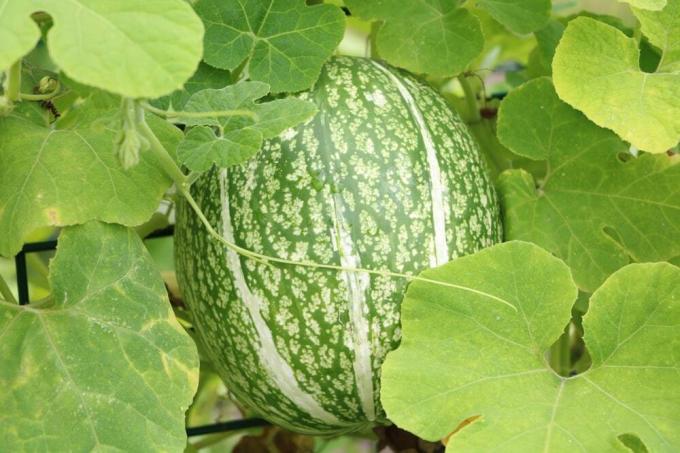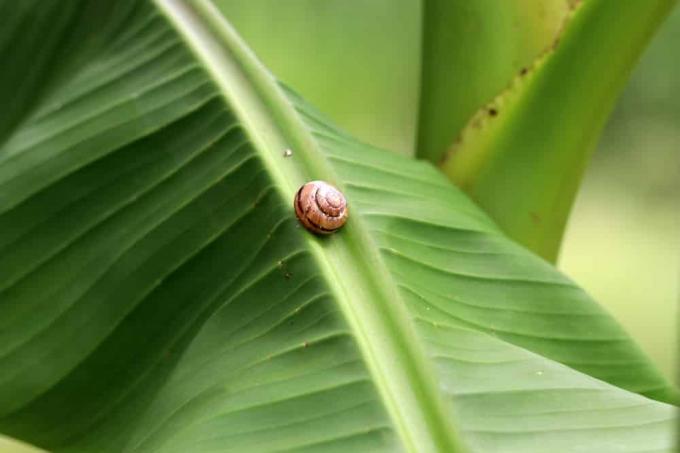

Table of contents
- location & soil
- Sowing & Planting
- Container planting & greenhouse
- watering & fertilizing
- fruits & growth
- harvest time
- Diseases & Pests
The watermelon has the botanical name Citrullus lanatus and originally comes from West Africa. Because of the sweet pulp, this type of fruit is popular all over the world as a tasty snack. Due to the hard shell, the large fruits are easy to transport, and melons are often imported from distant countries. Nevertheless, with the right approach, cultivation and breeding are also possible in the local latitudes.
location & soil
In general, melons place high demands on their location and do not thrive everywhere. Although watermelons belong to the cucurbit family, the plants are much more sensitive to the local cold than native cucumbers and squashes. Due to its African origin, the plant depends on warm and bright site conditions. If these conditions are not right, the watermelon cannot grow healthily and will not produce a bountiful harvest. In extreme cases, the wrong site conditions can even lead to the death of the entire plant.
- A warm and sunny location is ideal
- Needs at least 6 hours of sun exposure per day
- A bed in front of a south wall is well suited
- Prefers humus-rich, well-drained and sandy soils
- Pay attention to loose and light soil qualities
- Loosen up extremely heavy and loamy soils with sand
- pH should be between 6 to 7
- Pay attention to wind-protected place
- Avoid cool drafts and strong gusts of wind
- Rearing in a warm greenhouse is optimal
Tip:
In order to guarantee the watermelon a sun-drenched location, it is advisable to build a raised bed. This way she can grow magnificently in a slightly elevated spot with plenty of sunlight.
Sowing & Planting

The sowing and planting of the exotic plants are quite easy. However, the heat-loving watermelons do not germinate outdoors in the local latitudes because the temperatures are too low. Therefore, growing outdoors requires pre-growing in sheltered indoor spaces or in greenhouses. When growing, it is important to have enough space in the bed on all sides so that the watermelons with their large fruits can spread out undisturbed. If there is not enough space to grow, the harvest will be significantly smaller.
- Grow from seed at a minimum of 21°C
- Place the culture vessel on a light-flooded windowsill
- Germination takes about 7-14 days
- Allow young plants to grow for a total of 3-4 weeks
- Plant out after the ice saints have already warmed up
- Enrich the soil beforehand with plenty of mature compost
- Create a drainage layer of gravel or quartz sand
- Dig a sufficiently large planting hole
- Roots must fit and must not bend
- Requires area of about 1 to 2 square meters
- Happy about a supporting trellis
- Water only moderately at first, then increase the water dose
A notice:
When growing, a slow and careful transition from the room to the full sunlight of the garden is crucial. Therefore, plant out the sensitive plants on a cloudy day that is not too hot.
Container planting & greenhouse
As an alternative, watermelons can also be grown in a bucket. In this way, cultivation is also possible without a garden on a balcony or terrace. However, a sufficiently large vessel is required for the success, so that the plant can spread well. However, potted plants should not stand in the blazing sun all day, otherwise the soil will dry out much too quickly and the harvest will be ruined. Growing watermelons in a greenhouse is ideal, as the temperature here is pleasantly warm even in spring. In addition, there is no risk of late frost nights, which could lead to the death of the plants.
- Compact growing varieties are ideal
- Select buckets with a large volume
- Conventional garden soil is not suitable for keeping in tubs
- Use nutrient-rich plant substrate instead
- Enrich with a part of sand and clay
- Compost-based substrates are also well suited
- A partially shaded location on the balcony or terrace is ideal
- Protect plants from intense midday heat
- Grow from seed in the greenhouse in early spring
- Ensure adequate ventilation to prevent rot
- Open windows and doors for a few hours every day
- Especially during the flowering phase to allow pollination
watering & fertilizing

Watermelons come from tropical countries and have a large water requirement. The soil must never dry out completely, otherwise damage will quickly occur and the plant will die. Therefore, Citrullus lanatus has to be watered a lot and often, especially in summer. In addition, the water requirement increases when the plant is in the fruiting phase. In addition, watermelons also have high nutritional requirements. Most floors can only cover these requirements to a limited extent. Therefore, regular fertilization is advisable when growing, so that the melons can grow splendidly. If the crops do not get enough nutrients, even the entire harvest can fail. However, young plants must wait about four weeks after planting so that they can get used to the new location in peace.
- Water thoroughly and daily, preferably in the morning
- Even water twice on hot summer days
- Never use cold tap water
- Stale and lukewarm watering water is better
- Ideally collect rainwater
- Not getting the leaves wet will cause powdery mildew disease
- Absolutely avoid waterlogging
- Give nitrogenous fertilizers every two weeks
- Organic liquid fertilizer is ideal for vegetables
- Alternatively, organic horse manure is well suited
Tip:
Before fruiting, it is recommended to fertilize once a week to support Citrullus lanatus with additional nutrients.
fruits & growth
Like cucumbers and pumpkins, melons grow as annual plants, so overwintering is not possible. For this reason, the plants are torn out of the ground after harvest and then completely disposed of on the compost heap. Most watermelons form a bright red flesh. However, there are also varieties with yellow, green, orange or white flesh, which are mainly available in specialized fruit and vegetable shops. The high water content of the fruit is very refreshing, especially when enjoyed chilled in summer. Since watermelons have a high water requirement, the soil is constantly moist. In order to avoid rotting fruit, it is therefore advisable to place sheets of Styrofoam or similar materials under the melons. In this way, direct contact with the permanently damp soil and the resulting signs of rot can be avoided.
- Plants form thin and angular stems
- Long habit with many branched tendrils
- Can grow up to 10 m in extreme cases
- Forms pinnate leaves that are hairy on both sides
- Light yellow flowers develop from June
- Then round fruits develop, sometimes rather oblong
- Fruits are made up of 95% water
- Contain a lot of vitamins A and C
- Melons keep gaining weight
- Can be up to 50 cm thick and weigh up to 20 kg
- Slump down and lie on the floor
- Shell is a hard shell up to 4 cm thick
harvest time

Watermelons have a long ripening period compared to other types of fruit. In order for the large fruits to taste delicious and juicy, melons have to ripen sufficiently. Only over time does the usual sweet taste develop. To determine the degree of ripeness of a watermelon, it is necessary to pay attention to certain signs. This includes a dark green skin with yellowish spots. A dull sound is produced when the shell is tapped, and the leaves also begin to wither. In autumn, the parts of the watermelon plant turn brown before the first frost and then die. This is usually a sign that the fruit is fully ripe. For this reason, from a botanical point of view, Citrullus lanatus should actually be classified as a vegetable and not as a Fruit can be viewed as all outer plant parts with the timing of ripening fruit die.
- Harvest possible from the end of August to autumn
- Size is not a guaranteed indication of ripe fruit
- The contact point of the shell changes color from white to yellow
- Check maturity by knocking
- Separate the fruit from the plant with a sharp knife
- Leave the stalk standing, this keeps the tank closed longer
- As a result, the melon has a longer shelf life for consumption
- Store at room temperature but not in the sun
- Uncut fruits can be stored for up to 2 weeks
- Store in the fridge after cutting
Diseases & Pests

In general, Citrullus lanatus is a robust plant that grows healthy and lush with the right site conditions and care measures. However, under certain circumstances, diseases and pests can occur if these factors are imbalanced. The causes are often compacted soil, prolonged waterlogging and frequent water shortages. In addition, too much salt in the soil can weaken the immune system of the plants. Especially in the greenhouse, fungi sometimes penetrate the roots or the root neck of the plant and lead to premature death. Therefore, growing resistant and extremely hardy strains is recommended. In addition, the crop rotation must be observed. Melons may not be grown where other cucurbits grew in the previous year. Young melon plants are also a delicacy for voracious slugs.
- Fusarium wilt and red spider occur in the greenhouse
- Inspect the plant regularly to prevent rampant infestation
- Always ensure sufficient humidity
- Beneficial insects are suitable for fighting
- These include the predatory mite Phytoseiulus persimilis and predatory bugs
- Also use parasitic wasp larvae, lacewings and hoverflies
- Susceptible to aphids, downy and powdery mildew
- Take protective measures against snail infestation
- Scatter chopped straw around the plants
- Lay out slug pellets in the bed
 Home editorial office
Home editorial office
Learn more about Exotic Fruits

Mexican mini cucumber, Melothria scabra: Care from A – Z
The Mexican mini cucumber promises a refreshing treat for the palate in the summertime. As an annual climbing plant, the tropical pumpkin plant with yellow flowers is a pretty eye-catcher in the bed and on the balcony. The pretty Melothria scabra combines its exotic charm with modest demands. Read a tried-and-tested guide to care from A to Z here.

Lulo, Solanum quitoense: Care of the Quitorange from A to Z
Lulo, Solanum quitoense or Quitorange - the South American plant and its fruits are in this country almost unknown but have some advantages both as an ornamental plant and as a fruit-bearing shrub offer. All details from care to effect can be found here.

Zierbanane, Musa Banana - care and instructions for wintering
With its majestic shape, the ornamental banana is a welcome guest in conservatories and imaginatively designed living spaces. The tropical Musa Banana looks gorgeous in a bucket on a summery balcony. This guide provides you with detailed information about the right care and provides well-founded instructions for overwintering the tropical beauty of plants.

Planting an avocado seed – this is how you grow an avocado tree
Avocados are already a delicacy in the local kitchen and it is hard to imagine life without them. But the plant is also becoming increasingly popular in the local latitudes in tubs as a houseplant. So if you still have seeds left after processing, you can plant them.

Growing Sharon fruit - how to grow persimmon plants from seed
The Sharon fruit, also known as the persimmon tree, is not yet widespread in the local latitudes. As a rule, the tree is cultivated here in a bucket because it is not hardy. The seeds of the fruit are now also being offered more and more frequently for your own cultivation.

Avocado, Persea americana: profile and nutritional values - is it healthy?
For a long time, the avocado was spurned as a calorie bomb. Today, the green fruit has established itself as a superfood and is experiencing a boom. Is Persea americana healthy or not? This profile and a look at the nutritional values shed light on the darkness.



